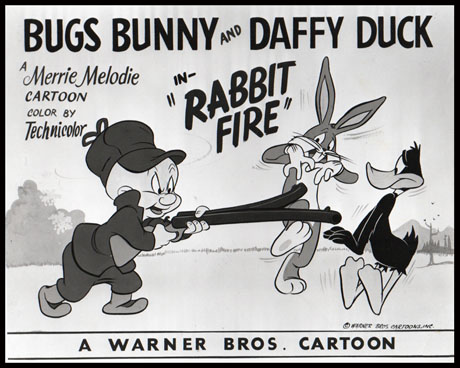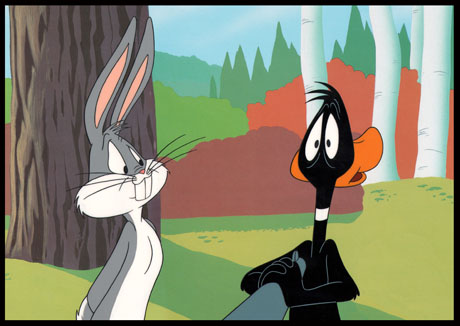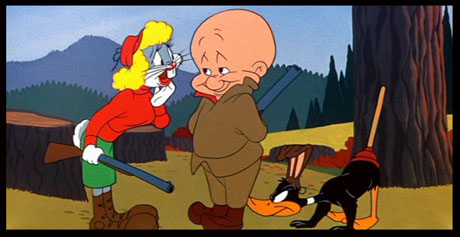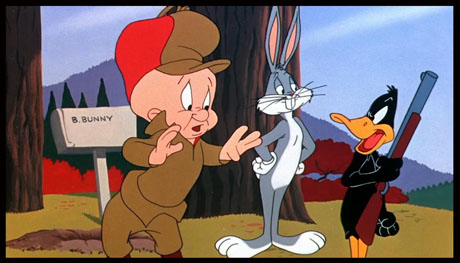
Moviegoers have seen some impressive conflicts depicted on screen: Rocky Balboa and Apollo Creed, Luke Skywalker and Darth Vader, The Avengers, and Thanos. But few, if any, reach the heights of Bugs Bunny and Daffy Duck, head-to-head, shouting at one another, while Elmer Fudd stands nearby with his shotgun at the ready
This month marks the 70th anniversary of the start of this feud between these three stars. Rabbit Fire, released on May 19, 1951, was the first time Bugs, Daffy, and Elmer squared off, starting a feud that’s gained icon status in animation history.

The short opens with now-familiar animation image and dialogue, as Elmer Fudd makes his way through the forest, shotgun in hand, and turns to the camera to inform the audience, “Be vewy vewy quiet, I’m hunting rabbits.”
Elmer has been following rabbit tracks, which lead to the rabbit hole of “B. Bunny” (as it states on his mailbox). However, the tracks are being made by Daffy Duck, with a pair of fake rabbit feet.
What ensues is Elmer trying to hunt Bugs, Bugs convincing Elmer that he should instead be hunting Daffy, in the now, also iconic “Duck Season! Wabbit Season!” exchange between the two, usually resulting in Daffy getting blasted by the shotgun and his bill in a hilarious and precarious position.
The two also dress up and imitate each other to throw Elmer off. This sequence is even more impressive from a vocal performance standpoint when one realizes that master voice artist Mel Blanc had to provide what Daffy’s voice would sound like if Bugs was doing it and vice versa.

There’s also a sequence in which Bugs dresses in drag (another iconic gag in future shorts) as a female hunter with Daffy as his dog. When Elmer eventually sees through this, Bugs and Daffy begin tearing Rabbit Season and Duck Season posters off a nearby tree, eventually revealing one that reads: “Elmer Season.”
With a vicious glare, the two turn the tables and begin hunting the hunter, ending the short by stating: “Be vewy, vewy quiet. We’re hunting Elmers.”
Rabbit Fire could have only been brought to the screen by the legendary genius of Chuck Jones (billed here as “Charles M. Jones”). Not only does the short have lush, full animation and backgrounds (here by one of his regular partners Philip DeGuard), but the comic timing in Rabbit Fire rivals anything seen in live-action.
Jones not only incorporates memorable sight gags but was also unafraid to slow the animated action down for pauses, which allows us to anticipate the laugh that is about to come and makes the short funnier, no matter how many times you’ve seen it.
An example of this is the scene in which, after getting another round of Elmer’s buckshot to the face, courtesy of Bugs, Daffy takes a few slow steps right up to Bugs’ smirking face before informing him, “You’re despicable.”

Another is when Bugs attempts to get Elmer interested in sports other than hunting, at which point, Daffy emerges, dressed in whites with a racquet in his hand, asking, “Anyone for tennis?” Elmer just shoots him, the smoke clears and reveals a singed Daffy wearily declaring, “Nice game!”
Jones’s innate comic sensibilities are on full display. In his book Chuck Amuck: The Life and Times of An Animated Cartoonist, published in 1989, he discussed why the audience responds to humor, like that in Rabbit Fire: “Every great comedian makes himself available to his audience. That is, the traits that define his personality the audience must be able to recognize in themselves-even though, as, in the case of a Daffy or Bugs, they do not have the courage to exercise them.”
Rabbit Fire was so popular that Bugs, Daffy, and Elmer teamed up again for two more short subjects Rabbit Seasoning (1952) and Duck! Rabbit! Duck! (1953). The cartoons have become affectionately referred to as “The Hunting Trilogy,” as the plots are so similar and, yet, so distinctly funny.

Rabbit Fire marked the first time Bugs and Daffy starred together (Bugs had made a cameo in 1943‘s Porky’s Pig’s Feat, which also starred Daffy), but with Rabbit Fire, they were both the headliners.
Seventy years later, their dynamic together, partnered with Elmer’s gentile cluelessness, has, rightly so, become the stuff of animation legend.
In his book, Hollywood Cartoons: American Animation In Its Golden Age, author and animation historian Michael Barrier summed up the success of Rabbit Fire and the other films of “The Hunting Trilogy” by noting that they succeed “…as aerobatic feats: watching Jones bring Bugs and Daffy through these cartoons whole is like watching circus aerialists perform without a net.”
- An Eye for A Classic: The 60th Anniversary of “Mr. Magoo’s Christmas Carol” - December 22, 2022
- A Very Merry Mickey: The 70th Anniversary of “Pluto’s Christmas Tree” - December 19, 2022
- A Fine French Feline Film: The 60th Anniversary of “Gay Pur-ee” - December 12, 2022


 May 22nd, 2021
May 22nd, 2021  Michael Lyons
Michael Lyons  Posted in
Posted in 






